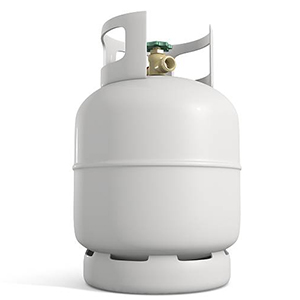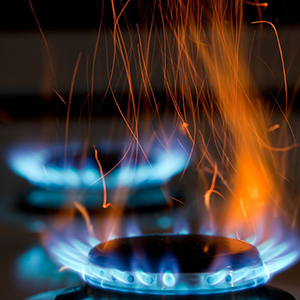What's the Difference Between a Propane and Natural Gas Range?
Which fuel do you use for your gas range, ovens and grills? We would choose between propane, a fossil fuel transported via pipeline, and natural gas, a type of liquefied petroleum gas that is usually filled and transported using bottles. Is there any difference between propane range and natural gas range using different fuels, Chefmax will cover propane and natural gas in detail in this article to help you understand and choose.
Table of Contents
1. What is propane and natural gas?
Propane is a by-product of the processing of crude oil or natural gas, usually in gaseous form, but usually compressed into a liquid form and then filled into bottles for transport. Propane is commonly used as a fuel for engines, grilled foods and home heating systems. In sales, propane is commonly referred to as liquefied petroleum gas, which is often mixed with propylene, butane and butene. In order for accidental leaks to be detected as quickly as possible, ethanethiol, which has a pungent odor, is typically added to commercial LPG.
Natural gas is a fossil fuel that is composed primarily of hydrocarbons and contains non-hydrocarbon gases, which produce a yellow or blue flame when burned. Methane makes up the majority of the gas, with small amounts of ethane, propane and butane. Thiol and tetrahydrothiophene are used to add odor to natural gas before it is sent to the end user to aid in leak detection.
The main use of natural gas is as a fuel to make carbon black, chemicals and liquefied petroleum gas. Propane and butane produced from natural gas are important raw materials for modern industry.

2. What is the difference between propane and natural gas?
When you use propane and natural gas in the kitchen rather than in industry, there is not much difference between them in terms of combustion, heating and drying, but more of a difference in cost, transportation and storage. Here are the four areas where they differ most, which will help you choose which fuel type you need.
A. Price cost
Generally speaking natural gas is cheaper.
The volume of propane is usually measured in liters (or gallons), while natural gas is measured in cubic meters. For comparison purposes, the same volume units are used in calculating heat production.
Based on British thermal units BTUs (i.e., the amount of heat required to warm one pound of pure water from 59 degrees Fahrenheit to 60 degrees Fahrenheit at standard atmospheric pressure), one cubic foot of natural gas provides about 1,000 BTUs of heat, while one cubic foot of propane provides 2.5 times more heat than natural gas, or about 2,500 BTUs, indicating that for the same amount of heat provided, the amount of propane required is less than natural gas to provide the same amount of heat.
Based on the heat generation efficiency, propane is at least 2.5 times more expensive than natural gas, plus the cost of bottling and transporting it, so propane will be more expensive and natural gas less expensive by comparison.
B. Installation Costs
Consumers can purchase filled propane at the filling station and have it delivered back to their kitchens, and used empty bottles can be returned to the filling station for refilling. For restaurant kitchen owners, using propane as a fuel requires no piping and allows the equipment to be used outdoors (you can carry the propane bottle anywhere and simply connect it to the kitchen equipment using a hose).
Natural gas, in contrast, is delivered to each location through a fixed pipeline and does not need to be filled and transported back and forth, but the initial cost of planning a fixed location and installing the pipeline is higher. In addition, you will need to convert your equipment to accommodate natural gas (by replacing piping, fittings, or replacing the entire unit) if your previous unit was using propane.
In urban areas, natural gas is used more often because of better gas supply lines, while in rural areas, where gas lines are difficult to spread, propane tanks offer a great convenience. In summary, if you have a basic natural gas line right near your kitchen, using a natural gas stove is a very smart choice, while if you fancy the mobility and portability of propane, you can use propane gas cylinders for outdoor cooking.
C. Environmentally friendly
There is not much difference between propane and natural gas in terms of combustion and heating, both are clean fuels, burning produces water vapor and carbon dioxide, but the main component of natural gas is methane, which is a greenhouse gas, it has a higher impact on the environment than carbon dioxide, but pollution is minimal without leaks, in the case of natural gas pipeline leaks they enter the air and eventually decompose into carbon dioxide.
Natural gas combustion emits less than coal, about half the emissions of coal combustion, but in general, propane is cleaner because it is completely harmless to the environment and if a leak were to occur, it would not contaminate the soil, air or water and would have no impact on the local environment.

D. Storage
One of the differences in the physical properties of propane and natural gas is the way it is liquefied and transported. Propane transforms into a liquid at -43°C, but can remain liquid at higher temperatures under pressure. It can be purchased at most filling stations and can be stored and carried in portable stainless steel tanks. Once the pressure is released through the valve, propane turns into a gas immediately above -42 degrees Celsius. Although mostly used in portable stoves or barbecues, propane can also be used to fuel heating equipment.
Natural gas can be stored in different forms, including compressed, liquid and non-compressed natural gas. In most cases, natural gas needs to be compressed before it is stored or transported. This form is easier to move and release and can be transported through pipelines and released through valves. Natural gas is mainly supplied by pipeline through utility companies, but storage tanks can be used where pipelines are not laid. This form of gas is extremely pressurized, so there is a small risk of rupture if the storage unit is not properly maintained.
To convert natural gas into a liquid it must be cooled to below -162°C. At such low temperatures, it requires less space than compressed natural gas, so larger quantities can be stored and transported in isolated containers. Although special insulated containers are required for maintaining the liquid form, this type of storage is safer because any leaks would evaporate in the air.
E. Risk factors
Propane is heavier than air and heavier than natural gas, so in the event of a leak, propane is more likely to collect near the ground above rather than dissipate, and when the concentration of the burning gas in the air reaches a certain level, not only will it be more likely to poison people, but the slightest spark can lead to combustion and explosion. Compressed natural gas is stored under high pressure and is more likely to explode when the storage tank is damaged.
Both of these gases have a risk factor, so it’s a good idea to completely shut off valves when not in use and to check valves and piping regularly, preferably with a gas leak detection device (similar to a smoke alarm) that will alert you if an abnormal gas leak is detected.
Likewise, you need to determine if appliances such as gas stoves and ovens have complete safety precautions, such as flame out protection, which stops the gas supply and prevents gas leaks if the flame is accidentally turned off. It is also important to have a full gas range of quality certifications, and you should look for a trustworthy supplier for both products and after-sales service.
3. Can I change the fuel for my stove?
The answer is yes. Propane and natural gas have different densities and energies. Propane has more energy for the same volume, so when converting a propane range to a natural gas range, it is likely that a larger diameter pipe supplying more natural gas will be needed to achieve the previous energy efficiency.
However, it is best not to change fuel types directly without any professional guidance. Propane range conversion to natural gas range requires changing fittings and piping, but many natural gas ranges are difficult to convert to propane range because natural gas is usually kept at low pressure, while propane needs to be kept in liquid form at high pressure, and many equipment cannot accommodate the high pressure of propane even after adjustment, and changing fuel in this case is likely to Changing fuels in such cases is likely to affect energy efficiency and cause equipment damage.
Some suppliers sell equipment with a gas conversion kit, which indicates that the equipment can be converted between the fuel types allowed in the manual. If this is not the case, it is best to consult the supplier for a definitive answer before changing. The good news, You can contact Chefmax for professional solutions
























